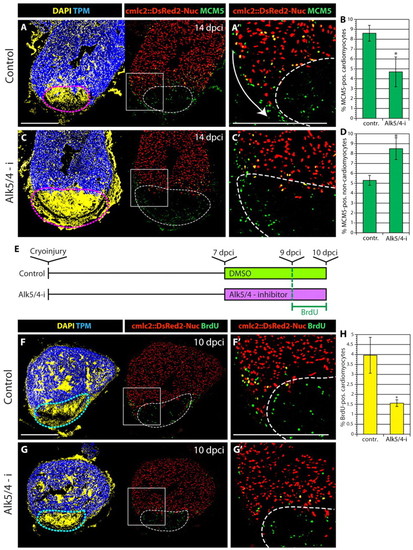Fig. 7
- ID
- ZDB-FIG-120601-19
- Publication
- Chablais et al., 2012 - The regenerative capacity of the zebrafish heart is dependent on TGFβ signaling
- Other Figures
- All Figure Page
- Back to All Figure Page
|
TGFβ/Activin signaling promotes cardiomyocyte proliferation during heart regeneration. (A,A2,C,C′) Heart sections of transgenic cmlc2::DsRed2-Nuc (red) fish immunostained for Tropomyosin (blue) and Mcm5 (green) to detect mitotic cells at 14 dpci. DAPI (yellow in the left panels) marks nuclei. Proliferating cardiomyocytes are identified by co-expression of DsRed2 and Mcm5. The post-infarcts are encircled by dashed lines. (A′,C′) Higher magnifications of the boxed areas in A,C. (A,A′) In control hearts, proliferating cardiomyocytes are located in the vicinity of the injury site. Non-cardiac Mcm5-positive cells are distributed predominantly at the post-infarct wall. Arrow (A′) indicates the invasion of new myocardium. (C,C′) Exposure to Alk5/4-i attenuates cardiomyocyte proliferation and expansion. (B) The ratio of Mcm5-positive DsRed2-positive nuclei to all DsRed2-positive nuclei demonstrates a reduction of proliferating cardiomyocytes after drug treatment (n=10). (D) The ratio of Mcm5-positive to DAPI-positive nuclei shows enhanced proliferation of non-cardiac cells after drug treatment (n=10). (E) Experimental design to demonstrate the immediate effect of Alk5/4-i on cardiomyocyte proliferation. (F-G′) Confocal images of hearts from cmlc::DsRed2-Nuc (red) transgenic fish. Tropomyosin (blue), DAPI (yellow), BrdU (green). Proliferating cardiomyocytes are identified by the co-expression of DsRed2 and BrdU. Dashed lines indicate the post-infarct. (F′,G′) Higher magnifications of the boxed areas in F,G. (H) The ratio of BrdU-positive DsRed2-positive nuclei to all DsRed2-positive nuclei. BrdU incorporation in cardiomyocytes was significantly decreased after Alk5/4-i exposure. Error bars indicate s.e.m.; n=10; *P<0.05, t-test. Scale bars: 300 μm. |

